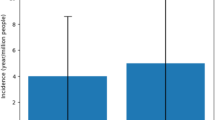Abstract.
Fourier transform infrared microspectroscopy (FTIRM) has been used to study the changes in mineral and matrix content and composition in replicate biopsies of nonosteoporotic human cortical and trabecular bone. Changes in osteonal bone in these same samples were reported previously. Spectral maps along and across the lamellae were obtained from iliac crest biopsies of two necropsy cases. Mineral:matrix ratios, calculated from the integrated areas of the phosphate ν1, ν3 band at 900–1200 cm−1 and the amide I band at ≈1585–1725 cm−1, respectively, were relatively constant in both directions of analysis, i.e., along and across the lamellae. Analysis of the components of the ν1, ν3 phosphate band with a combination of second-derivative spectroscopy and curve fitting revealed the presence of 11 major underlying moieties. Of these, the ratio of the relative areas of the two underlying bands at ≈1020 and ≈1030 cm−1 has been shown to be a sensitive index of variation in crystal perfection in both human osteonal bone and in synthetic, poorly crystalline apatites. This ratio was calculated in both cortical and trabecular bone from human iliac crest biopsies along and across the lamellae. The ratio decreased, going from the periosteum to the medullary cavity in the cortical bone, and from the periphery towards the center of trabeculae. These observations were consistent within serial sections obtained from the same biopsy, multiple biopsies obtained from the same necropsy specimen, and biopsies obtained from the two different necropsy specimens. The results presented here along with previously reported changes in osteonal bone show a relation between bone age and ``crystallinity/maturity'' (a parameter dependent on crystallite size, hydroxyapatite-like stoichiometry, abundance of substituting ions such as CO3 2−; the more crystalline/mature, the more hydroxyapatite-like stoichiometry, the bigger the crystallite size, the less the ion substitution by ions such as CO3 2−) as deduced by the 1020/1030 cm−1 ratio. Invariably, younger normal bone is less mature/crystalline than older. These results provide a ``baseline'' for description of mineral properties, to which diseased bones may be compared.
Similar content being viewed by others
Author information
Authors and Affiliations
Rights and permissions
About this article
Cite this article
Paschalis, E., Betts, F., DiCarlo, E. et al. FTIR Microspectroscopic Analysis of Normal Human Cortical and Trabecular Bone. Calcif Tissue Int 61, 480–486 (1997). https://doi.org/10.1007/s002239900371
Published:
Issue Date:
DOI: https://doi.org/10.1007/s002239900371




